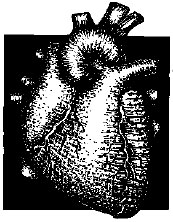Bench to Bedside
Understanding heart failure
By Arnold M. Katz, M.D.
Hippocrates, in fifth-century b.c. Greece, described patients who suffered from shortness of breath and edema, including those with heart failure, and attributed this syndrome to an excess of "phlegm" (the "cold humor") moving from the brain to the chest. This view persisted for almost 2,000 years, until 1628, when Harvey discovered how blood circulates. But Harvey's finding only explained how the impaired pumping of a diseased heart might cause breathlessness, not the accompanying accumulation of fluid.

|
|
The new paradigm sees heart failure not just as a weakened
pump, but also as accelerated cardiac myocyte death. |
In the 1920s, when the diuretic properties of organic mercurials were identified, the focus of heart failure research shifted to the kidneys. Researchers learned how altered renal function causes salt and water retention, an abnormality that is part of the neurohumoral response —the body's way of compensating for reduced cardiac output. Over the next few decades, other components of this response, including vasoconstriction and stimulation of the heart, became clear.
Fluid: When orally administered diuretics were developed in the 1950s and 1960s, the clinical picture in heart failure changed again; patients no longer suffered from fluid accumulation, but instead were troubled by weakness and fatigue. In the 1970s, investigators realized that arteriolar vasoconstriction reduces cardiac output and overloads the failing heart, so they introduced vasodilator therapy. Then they found that levels of norepinephrine, a key mediator of the neurohumoral response, were elevated in patients with heart failure and contributed to fluid retention and vasoconstriction. Soon, abnormal levels of other neurohumoral mediators were found in such patients—including the vasoconstrictor peptide angiotensin II, which also causes hypertension. Clinical trials showed that ACE inhibitors, which retard the formation of angiotensin II, cause a short-term improvement in heart failure symptoms and also increase long-term survival.
The discovery in 1967 that heart muscle contraction, or contractility, is weakened in failing hearts stimulated efforts to develop inotropes, drugs that increase contractility. By the mid-1980s, there was consensus that the judicious use of diuretics, vasodilators, and inotropes could solve most of the problems associated with heart failure. According to this paradigm, the use of betablockers is misguided because they weaken contractility.
By the late 1980s, it was clear that the prognosis for patients with heart failure was worse than for those with most cancers, with fewer than 50% surviving five years. At the same time, most vasodilator trials and virtually all trials using inotropic drugs yielded an anomalous result: in spite of short-term clinical improvement, long-term survival was reduced. The clinical use of most vasodilators and of all inotropes was thus abandoned. ACE inhibitors were an exception because their survival benefit was so dramatic. Even more surprising was the recent demonstration that beta-blockers prolong long-term survival, even though they initially worsen heart failure by blocking the stimulant effect of norepinephrine. This anomaly has undermined the paradigm that heart failure is simply a pumping disorder.
Hypertrophy: The current explanation for these anomalous findings is that the neurohumoral response, which stimulates the heart to enlarge (a condition known as hypertrophy), also damages the muscle cells (called cardiac myocytes). Following hypertrophy, cardiac myocytes assume molecular characteristics formerly seen in the fetal heart. This reversion to the fetal phenotype was described by Shakespeare in As You Like It, with "the infant, mewling and puking in the nurse's arms" giving way eventually to "second childishness and mere oblivion—sans teeth, sans eyes, sans taste, sans cardiac output, sans everything." (The italic addition is mine!)
Second childhood is not an exact replica of the first, and the same is true for the failing heart. Adult cardiac myocytes can live for more than 100 years, but they cannot be replaced. When stimulated to grow larger, however, they wear out sooner. Neurohumoral mediators like norepinephrine and angiotensin II stimulate the failing heart to grow, but also cause myocytes to die prematurely, so that the failing heart is like an overloaded car with a fragile engine. When there's one heavy foot on the accelerator and another on the brake, both the engine and the drive train wear out quickly.
Search: So the new paradigm sees heart failure not just as a weakened pump, but also as accelerated cardiac myocyte death, with growth stimuli as a major cause of premature death. Now the search is under way for better methods to stop these molecular processes.
Katz, a visiting professor of medicine at Dartmouth since 1995, is also a professor of medicine emeritus and former chief of cardiology at the University of Connecticut.
